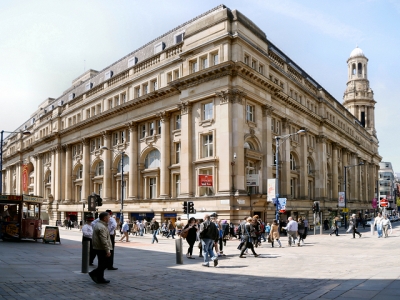
Cottonopolis was a 19th-century nickname for Manchester, as it was a metropolis and the centre of the cotton industry.
Early cotton mills powered by water were built in Lancashire and its neighbouring counties. In 1781 Richard Arkwright opened the world’s first steam-driven textile mill on Miller Street in Manchester. Although initially inefficient, the arrival of steam power signified the beginning of the mechanisation that was to enhance the burgeoning textile industries in Manchester into the world’s first centre of mass production. As textile manufacture switched from the home to factories, Manchester and towns in south and east Lancashire became the largest and most productive cotton spinning centre in the world using in 1871, 32% of global cotton production. Ancoats, part of a planned expansion of Manchester, became the first industrial suburb centred on steam power. There were mills whose architectural innovations included fireproofing by use of iron and reinforced concrete.
The number of cotton mills on Manchester peaked at 108 in 1853. As the numbers declined, cotton mills opened in the surrounding towns, Bury, Oldham (at its zenith the most productive cotton spinning town in the world, Rochdale, Bolton (known as “Spindleton” in 1892) and in Blackburn, Darwen, Rawtenstall, Todmorden and Burnley. As the manufacturing centre of Manchester shrank, the commercial centre, warehouses, banks and services for the 280 cotton towns and villages within a 12-mile radius of the Royal Exchange grew. The term “Cottonopolis” came into use in about 1870.
The commercial centre of Cottonopolis was the exchange’s trading hall. The first of Manchester’s exchanges was built in the market place by Sir Oswald Mosley in 1727 for chapmen to transact business. It was subsequently re-built three times. Thomas Harrison built an exchange in the Greek Revival style between 1806 and 1809. After it opened, membership was required and trading was not restricted to textiles. Its early members were the owners of mills and warehouses, but later business was conducted by their agents and managers. Harrison’s exchange was enlarged between 1847 and 1849 by Alex Mills. After a visit in 1851, Queen Victoria granted the exchange the title the Manchester Royal Exchange. The third exchange, designed by Mills and Murgatroyd, opened in 1874. It was built in the Classical style with Corinthian columns and a dome. The Royal Exchange was lavishly re-built by architects Bradshaw Gass & Hope in 1914–21 and at the time had the largest trading room in the world. Its vast hall was 29.2 metres high and had an area of 3683 square metres. The exchange had a membership of up to 11,000 cotton merchants who met every Tuesday and Friday to trade their wares beneath the 38.5-metre high central glass dome. It was badly damaged in World War II and ceased operation for cotton trading in 1968.
Picture Credit : Google



